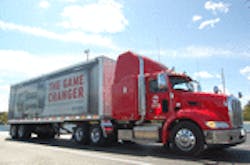INDIANAPOLIS. Even as it finalizes plans to become a public company, Allison Transmission said it still aims to make available for sale a fully automatic gearbox for Class 8 tractors by the fourth quarter of 2012 – a gearbox it believes will not only save fleets fuel but help them improve driver productivity as well.
During a ride-and-drive press event held here at its world headquarters, Melissa Sauer, Allison’s director of government and community relations, noted that the company is now in a “quiet period” following the recent filing of documents notifying the Security Exchange Commission (SEC) that it intends to make a public stock offering in the near future.
She stressed to the attending reporters that “no firm date” has yet been set for Allison’s public stock offering, noting that it remains an “ongoing process.” Originally a division of General Motors, Allison was sold for an undisclosed sum to private equity firms The Carlyle Group and Onex Corp. in 2007.
See video of the “Allison TC10 TS test drive”
However, even in the midst of its preparations to go public, Allison is entering the final development stage of its TC10 TS Class 8 transmission product – with the “TC” standing for the “twin countershaft” design of the gearbox as well as for the “torque converter” integrated into the unit, with the “TS” identifying it as the “tractor series” transmission.
“The Class 8 market is the one place we have a gap in our portfolio, and we intend to fill it,” noted James Wanaselja, Allison’s vp-North American marketing and services, at the event. “We’re looking to help fleets do more work and do it more efficiently with this transmission – increasing fuel savings, lowering maintenance costs and increasing ease of operations for drivers.”
Todd Dygert, product specialist for the TC10, said this Class 8 gearbox has been a long-term project for Allison lasting some eight to nine years, largely because the company wanted to thoroughly prove out that a fully automatic “wet clutch” transmission could deliver fuel economy gains, lower maintenance costs while improving vehicle and driver productivity to fleets.
“While we’re targeting all Class 8 tractor applications with the TC10, it fits the best with the most ‘shifting intensive’ duty cycles, such as urban pickup and delivery, LTL, and regional operations,” he noted, adding that the TC10 is rated to handle up to 600 hp. engines producing 1,650 lbs.-ft. of torque at launch – though testing has shown it can handle up to 1,850 lbs.-ft.
Right now, six tractors equipped with the pre-production TC10 gearboxes are being rotated through a variety of Class 8 fleets on a three- to four-week basis as part of Allison’s “concept validation” process, Dygert said.
That effort follows internal vehicle testing already conducted in extreme cold and hot climates (Minnesota and Death Valley, CA, respectively), along with mountain driving conditions at Loveland Pass, CO, and in the Appalachian mountains in Tennessee, added Mark Raines, one of Allison’s senior project engineers.
Dygert said fleets testing the TC10 are achieving fuel savings in both highway and local driving conditions, though he would not reveal specific numbers. However, he did point out that keeping a truck engine within its “sweet spot” longer, usually between 1,000 and 1,400 rpms, can translate into fuel efficiency improvements of 3 to 5%.
Those savings come from what he calls the TC10’s “blended architecture” that allows the 10-spd. gearbox (which has 10 forward and two reverse gears) to help reduce engine rpms at highway speeds – thus saving fuel – while maintaining constant power through rapid shifting in local driving conditions, thus maintaining a steadier, less fuel consuming load upon the engine.
“The key is reducing the ‘transient moments’ that occur between shifts,” Dygert explained. “That means there isn’t a falloff in power to zero as the transmission disconnects from the engine to change gears, which then results in a spike in engine rpms when the transmission re-engages.”
To achieve such “power shifts,” the TC10 relies on seven internal clutches that literally “hand off” engine power among themselves as the gears change – resulting in smoother, steadier, less fuel burning acceleration and deceleration, Dygert noted.
In testing to date, he said TC10-equipped tractors witnessed a 20% average increase in acceleration speed. That translates into allowing drivers to pass through more intersections before the traffic signals change, giving them an opportunity to improve daily work productivity.
Dygert also pointed out that that all seven clutches within the TC10 are “wet clutches,” meaning they are hydraulically controlled and constantly lubricated with oil, as opposed to mechanical or “dry” clutches.
Finally, some two to three years after the TC10 rollout at the end of 2012, Allison expects to introduce what it calls a “transmission health” monitoring system for this gearbox – one that that will use prognostics to alert drivers and maintenance personnel not only when oil and filter changes are due but if specific problems are developing that could threaten vehicle uptime.
“We’ve done a lot of customer surveys, and what lands at the top are reliability, durability, and uptime. They are the number one concerns of customers above fuel savings, because you can’t save on fuel if it [the transmission] doesn’t work,” explained Wanaselja. “Thus prognostics will play an important role in addressing those top concerns.”
About the Author
Sean Kilcarr
Editor in Chief
Sean Kilcarr is a former longtime FleetOwner senior editor who wrote for the publication from 2000 to 2018. He served as editor-in-chief from 2017 to 2018.
